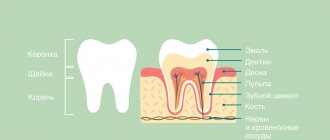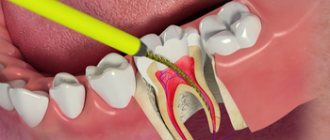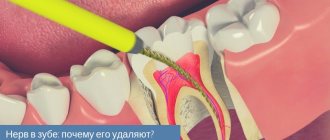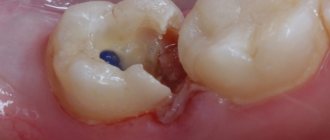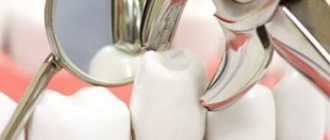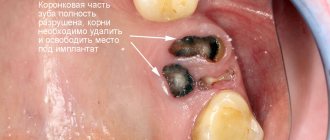Often, removal of the dental nerve, or pulp, is a necessary measure in the treatment of advanced dental pathologies. The procedure is quite complex, so it should only be performed by a qualified dentist with extensive practical experience.
To avoid medical errors and complications, contact the Mitino Dental Center. Our doctors know how to painlessly remove the nerve of a tooth and prevent its premature destruction.
Why is it necessary to remove a nerve?
Removal of the dental nerve is required in advanced inflammatory processes that affect both soft and hard tissue structures, including the pulp.
The most common reasons:
- periodontitis,
- pulpitis,
- benign neoplasm near the root,
- deep pulpal caries.
Depending on the type of pathological process and the size of the affected area, removal is carried out with partial preservation of the pulp or complete preservation from all canals. Amputation of part of the nerve is usually used for dental caries. In other cases, complete removal is usually necessary.
When is dental nerve removal required?
Depulpation is carried out in cases of severe damage to tooth tissue, advanced forms of caries, pulpitis, or benign formations near the root system. In addition, pulp removal is required during prosthetics and in case of medical error during root canal treatment.
Symptoms that you should contact your dentist for:
- constant aching or throbbing pain that does not go away even after taking painkillers;
- increased tooth sensitivity - a reaction to cold or heat, as well as sour, salty, sweet foods;
- pain while chewing food.
Such symptoms indicate the development of some pathology, so if they appear, you should immediately consult a dentist. The initial stages of dental diseases are treated quickly, and sometimes it is even possible to do without depulpation. The main condition is timely diagnosis and adoption of therapeutic measures.
Reference! Many patients are afraid to undergo depulpation, thinking that after it the tooth will begin to quickly decay. In fact, with proper care, it retains its functions for several years, then it is advisable to cover it with a crown. In some cases, pulp removal is the only sure way to preserve the tooth and avoid severe inflammatory processes.
Pulp - what is it for?
The pulp is a fibrous connective tissue penetrated by nerve endings and blood vessels.
Its shape completely follows the tooth, and is located in the center of the root part, filling the entire cavity. On top, the pulp is protected by a hard enamel layer, which prevents injury from the outside.
Main functions of the dental nerve:
- responsible for the formation, proper growth of teeth and blood supply;
- protects channels from pathogenic microbes;
- supplies the tooth with useful micro- and macroelements.
In addition, the pulp is responsible for the sensitivity of the tooth, that is, for its reaction upon contact with hot, cold, sour, sweet, and so on.
Reference! The dental pulp in adults is thinner than in children. This is due to age-related changes and a slowdown in regeneration processes. The older a person is, the thinner and weaker the nerve becomes, and the tooth begins to experience a deficiency of nutrients.
Nerve removal and canal filling: cost of treatment of multi-canal teeth
Different teeth have different numbers of canals, and the more canals a diseased dental unit has, the more difficult and time-consuming will be the removal of the nerve and the process of treating the dental canals. Naturally, the complexity of the treatment will affect its price. The average cost of nerve removal and subsequent treatment of a multi-channel tooth in Moscow is 10-15 thousand rubles
. The indicated amount will include all necessary manipulations, including installation of a permanent filling on the tooth.
Of course, prices for nerve removal and dental treatment are important when choosing a clinic, but should not be the main criterion. It is important not to save money on nerve removal; it is important to carry out treatment in such a way that in a couple of months you do not return to the clinic with a sore tooth and the need to re-treat it, or even remove it altogether!
Our dental clinic in Moscow “Firadent” provides a long-term guarantee for services, which is confirmation that we do our work responsibly!
Is it painful to remove a nerve?
It is difficult to say for sure how much a tooth hurts after nerve removal, since much depends on the person’s pain threshold. The depulpation procedure itself is performed under anesthesia. First, the doctor treats the injection site with special painkillers, and only after that introduces local anesthesia. It turns out that the process is painless from start to finish.
Pain may occur after the anesthetic wears off. The cause of discomfort is cleaning the canals, which injures soft tissues. If the procedure is performed by a qualified doctor, usually the tooth after nerve removal only hurts during the first day, then the pain gradually decreases.
A tooth hurts after nerve removal, what should I do?
Sometimes patients complain of pain in a pulpless tooth, which does not subside even over a relatively long time. It is important to distinguish between temporary pain and pain resulting from treatment errors. Temporary pain after pulp removal is normal, as is pain after caries treatment or tooth extraction. The reason for such sensations is that there has been an intervention in the tooth structure and it takes time for the family to accept the “foreign materials”. Pain after nerve removal occurs when the jaws are closed, when eating solid food, or when cold or hot liquid gets on the tooth.
To get rid of pain, you can use analgesics or traditional methods of getting rid of toothache.
If the pain does not go away on its own after a few days, you should consult a specialist. Sometimes patients from other clinics in Smolensk and the region turn to us, where they received poor-quality treatment. The most common cause is improperly processed dental canals, and less commonly, an allergy to the filling material. All this can cause tooth inflammation. If you neglect this problem, you may end up losing your tooth. The dentist will determine the cause of the pain and, if necessary, re-perform the procedure of cleaning the affected materials and filling.
Of course, regardless of the level of specialists and the stage of development of the disease, removing the nerve of a tooth is not a joyful event. But we must understand that the decision to remove the nerve is a necessary measure to avoid tooth extraction and stop the development of more serious oral diseases. You should not perceive the doctor’s decision as something terrible - modern dentistry allows you to minimize the consequences of nerve removal. Such “dead teeth” can serve you for decades without serious consequences, of course, if you brush your teeth on time and take care of your oral health.
How long does the nerve removal procedure take?
The duration of the procedure depends on the degree of neglect of the pathology. On average, anesthesia takes about 5–15 minutes, and root canal treatment takes about 30–40 minutes. Sometimes medicine is placed into the cavity and closed with a temporary filling, and at the next visit it is replaced with a permanent one.
This method is rarely used, most often in cases of severe damage to multi-rooted teeth. For single-rooted individuals, one visit to the dental office is usually sufficient.
Important! Independent removal of a temporary filling is strictly prohibited. This leads to infection of the open canal, which is extremely dangerous not only for the oral cavity, but also for the entire body.
Removal of a nerve and filling of one canal
Removal of the nerve and filling of one canal is usually performed in the treatment of the upper anterior canines and incisors and lower premolars, which usually have only one canal. In this case, the treatment process will be easier compared to the procedure for removing a nerve from multi-channel teeth. Therefore, its price will be lower.
On average, the cost of removing a nerve and filling one canal in Moscow will cost you 5-6 thousand rubles
. The indicated price will include nerve removal, anesthesia, canal treatment, and tooth restoration with a permanent filling.
YOU NEED TO REMEMBER! As you can see, removing the nerve of a tooth and its subsequent restoration is an expensive procedure, but most importantly, it leads to the tooth becoming dead. If you do not want to spend all your money on dental treatment and wisely save on dental services, do not delay treatment of caries and do not ignore regular preventive examinations at the dentist’s office.
Stages of treatment
First of all, the patient is sent for radiography. Diagnostics allows you to determine how many roots a tooth has and choose the most appropriate method of treating the pathology. The following describes the algorithm of actions for removing pulp in one session.
- Anesthesia. First, the injection site is treated with a special agent, after which an anesthetic is administered and left for about 5–15 minutes.
- Preparing the tooth for depulpation. To extract the pulp, it is necessary to provide access to it. To do this, the doctor opens the crown part of the tooth and then removes all affected tissue.
- Removal of the dental nerve. For these purposes, special instruments are used that quickly remove pulp from both the coronal and root parts.
- Installation of a seal. Depending on the location of the tooth, certain filling materials are used for filling - composites, dental cement, etc. Sometimes the doctor will place a temporary filling to ensure that the removal was completed correctly. In this case, a second visit will be required, during which the condition of the tooth is assessed, the temporary filling is removed, and then a permanent one is installed.
With complete removal, the pulp is removed from the coronal and root parts. If the inflammation has affected only the top of the tooth, partial depulpation is performed. In this case, only the coronal part is cut off, and the pulp in the area of the root system remains intact and fully retains its functions.
To make an appointment, call us at the phone number listed on the website. The specialist will answer all your questions and suggest the most convenient time to visit the doctor.
Toothache is one of the most unpleasant sensations a person knows. The tooth has a complex structure. Inside there are nerve endings and blood vessels, which together form the so-called pulp area. Thanks to this, we feel warm or cold. At the same time, it protects against the proliferation of harmful bacteria and provides nutrition to the tooth. Therefore, it is important to keep the pulp alive. But, if this is not possible, an operation is required to remove the pulp tissue, or in other words, removal of the nerve.
Modern methods used by Elena Plus dentists cause minimal discomfort. The clinic’s experienced doctors will prescribe effective individual treatment and restore the functionality of the tooth.
To delete or not to delete – that is the question
From the point of view of specialists, depulpation should be resorted to in extreme cases, trying to use less radical methods. In cases of pulpitis with extensive lesions, periodontitis, serious caries (large “hollow”), mechanical damage, orthopedic indications (prosthetics), it is often impossible to avoid surgery, so it is necessary to remove and clean the canals.
Unfortunately, the doctor does not have the opportunity to look inside the inflamed area and determine whether the pathological process is reversible. What will help? Only the doctor’s experience and attention to characteristic complaints of pain.
Depulpation is inevitable if:
- A person experiences a nagging, rather severe pain that appears unexpectedly and lasts a long time. When bending over or trying to lie down, the pain intensifies, as well as at night. Do not suppress them with analgin, this is a temporary measure and does not always help, urgently call the reception desk of the Elena Plus clinic.
- Discomfort occurs as a reaction to contact with cold or hot and continues for some time after the irritant is removed. A second, fleeting sensation of pain is a sign that not all is lost. However, pain when brushing teeth or biting is not a pulp problem.
Diagnosis is complicated by the fact that sensations are sometimes transferred to the other jaw, and this is typical for eights (wisdom teeth).
An X-ray will also not help determine the degree of reversibility or advanced stage of the problem, since inflammation of the soft tissue is not reflected in the image. Electrodontometry data are quite relative.
However, having collected all possible information, the doctor makes a “sentence” - it cannot be treated, it must be removed. If there are no contraindications, such as acute infection, stomatitis, open tuberculosis or viral hepatitis, a decision is made to completely or partially remove the pulp.
How to remove pulp
In dentistry, two methods of performing the operation are used:
- With the help of arsenic. The classic method is often very painful and time-consuming.
- With the use of anesthesia. Its advantages: no pain, comfort and speed.
Classic method
When choosing the first method, which has been around for decades, it is not arsenic that is actually used, but a special deadening paste based on arsenous anhydride, which makes up about one-third of the composition. The recipe contains painkillers, an antiseptic with an astringent and a filler. The paste is formed into a 10 mg ball and placed into the canals, previously expanded with a drill. After which it is closed with a temporary filling for 1-3 days.
The necrotizing agent gradually deadens the nerve. After the due date, the canals are opened, the dead nerve is removed, cleaned and a permanent filling is placed. You should be extremely careful and do not miss the deadline for removing the paste, so as not to destroy the dental tissues.
Despite its solid track record, this method is rarely used in modern therapy. At the Elena Plus clinic, preference is given to a more humane and effective method.
Treatment in one session
The use of anesthesia saves the patient’s time, the operation itself does not cause discomfort and is performed in one visit to the doctor, the risk of complications is minimized.
After performing an anesthetic injection, the dentist gains access to the nerve and removes it using specialized instruments without causing the slightest discomfort. The entire procedure takes up to thirty minutes. The instruments allow you to determine the length of the canal, ensure complete tissue removal, and thoroughly clean the canals, constantly monitoring the process. To be on the safe side, a temporary filling is placed. In this case, you will have to visit the doctor again. If everything went well, the filling will be replaced with a permanent one.
Possible complications
If we are talking about using arsenic paste, check with your doctor about its composition - is there any danger of an allergic reaction for you?
Pain that bothers you after nerve removal indicates that depulpation was incomplete or the canals were poorly cleaned. In this case, you need to visit the dentist again. If the pain is temporary, caused by invasion of dental tissue, an analgesic will help.
Still, is it painful to remove a nerve or not?
Each of us has our own characteristics of the structure of teeth and the height of the pain threshold. The disease also progresses individually. But when removing a nerve, the professionalism of the dentist and the equipment of the clinic are important.
The main advantage of the Elena Plus dental clinic is pain-free dental treatment, even in difficult cases!
Stages of the procedure
Before removing dental pulp, the following preliminary procedures are carried out:
- X-ray or visiography to clarify the diagnosis.
- Local or general anesthesia. The latter is used if there are certain indications or if the patient wishes.
- Isolation of the working area is carried out using a special latex film that protects against saliva getting on the aching tooth.
- At the same time, the carious cavity is cooled and processed, the pulp chamber is opened, and smooth walls are created in it.
After the preparatory procedures, the pulp is removed using a disposable pulp extractor.
This process is controlled using radiography and instrumental methods.
After the nerves are extracted from the desired dental canals, they need to be passed through and expanded, washed with an antiseptic and sealed. When the canals are sealed, an x-ray is taken for control.
Then, usually a temporary filling is installed on the tooth itself or, less commonly, a permanent one.


